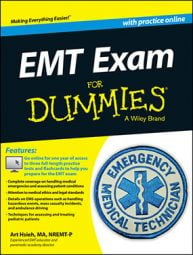You will need to know about lower airways conditions for the EMT Exam. Here’s a list of a variety of common conditions affecting the lower airway structures, causing shortness of breath.
| Problem | Signs and Symptoms | Action Steps |
|---|---|---|
| Asthma | Episodic respiratory distress; wheezes auscultated during breathing; may have past medical history; may have prescribed inhalers. | Assist with patient’s prescribed emergency inhaler if available; administer supplemental oxygen; ventilate if necessary to maintain oxygen saturation. |
| Bronchiolitis; respiratory syncytial virus (RSV) | Presents mostly in children to 2 years of age; gradual onset of fever, cough, and general weakness. | Wear personal protective equipment (PPE); administer supplemental, humidified oxygen. |
| Chronic obstructive pulmonary disease (COPD) | Chronic shortness of breath that has abruptly become worse; wheezes, crackles, or rhonchi auscultated during breathing; patient may be thin with an enlarged chest wall (emphysema) or appear bloated and heavy with dusky skin (chronic bronchitis); probable past medical history; may have prescribed inhalers; smoking history. | Assist with patient’s prescribed emergency inhaler if available; administer supplemental oxygen; ventilate if necessary to maintain oxygen saturation. |
| Cystic fibrosis | Genetic condition; chronic illness with acute worsening; heavy mucous production. | Help patient into a comfortable position; suction; administer supplemental oxygen; ventilate as needed to maintain saturation. |
| Pneumonia | Fever; 1–2 week history of flu or cold symptoms; productive cough with yellow to green sputum production; may auscultate crackles, rhonchi, or wheezes in lung fields; may have chest pain that worsens with cough. | Help patient into a comfortable position; administer supplemental oxygen (consider humidification). |
| Pulmonary edema | Sudden onset; may auscultate crackles or wheezes in lung fields or sounds may be very diminished as condition worsens; if hypertensive, may have jugular venous distension; pedal edema; in worse cases, produces frothy, pink-colored sputum with cough; may have history of congestive heart failure, hypertension, or myocardial infarction. | If blood pressure (BP) is normal or high, assist patient in sitting upright with feet dangling for comfort; administer supplemental oxygen; ventilate as necessary to maintain saturation. Consider continuous positive airway pressure (CPAP). |
| Pulmonary embolism | Sudden onset; lung sounds remain clear or may have a localized wheeze; may have chest pain; may have tender calf in lower leg; recent history of immobilization such as surgery or a long air flight; oral birth control user or smoker. | Administer supplemental oxygen; ventilate if necessary to maintain oxygen saturation. This condition may mimic psychogenic hyperventilation; do not use paper bag or withhold oxygen. |
| Spontaneous pneumothorax | Sudden onset; may occur after prolonged coughing or heavy lifting; lung sounds may be normal, or diminished on one side; may experience sharp chest pain; may have history of asthma, COPD, or connective tissue disease. | Help patient into a comfortable position; administer supplemental oxygen. |
A 52-year-old female is in respiratory distress. Her heart rate is 104, and her blood pressure is 148/82 mm Hg. She is breathing 24 times per minute and her oxygen saturation level is 95 percent. She tells you that she has been experiencing cold-type symptoms for ten days; during the last two days she has been producing yellow sputum when she coughs.
She has a history of asthma, angina, and hypertension, and takes medication for both conditions, including a rescue inhaler and nitroglycerin tablets. You note no accessory muscle use when she breathes. You auscultate her lungs and hear rhonchi. You should
(A)assist with administering her rescue inhaler.
(B)administer oxygen at 4 LPM via nasal cannula.
(C)administer oxygen at 15 LPM via a nonrebreather mask.
(D)assist with administering a nitroglycerin tablet.
The correct answer is Choice (B). The information provided in the question points to pneumonia as the underlying cause of the patient’s respiratory distress. There are no signs of an acute asthma attack or angina, so assisting with her medications, Choices (A) and (D), isn’t indicated.
Her level of respiratory distress is not severe, as indicated by a reasonable oxygen saturation level and lack of accessory muscle use. High-flow oxygen, Choice (C), isn’t indicated.

